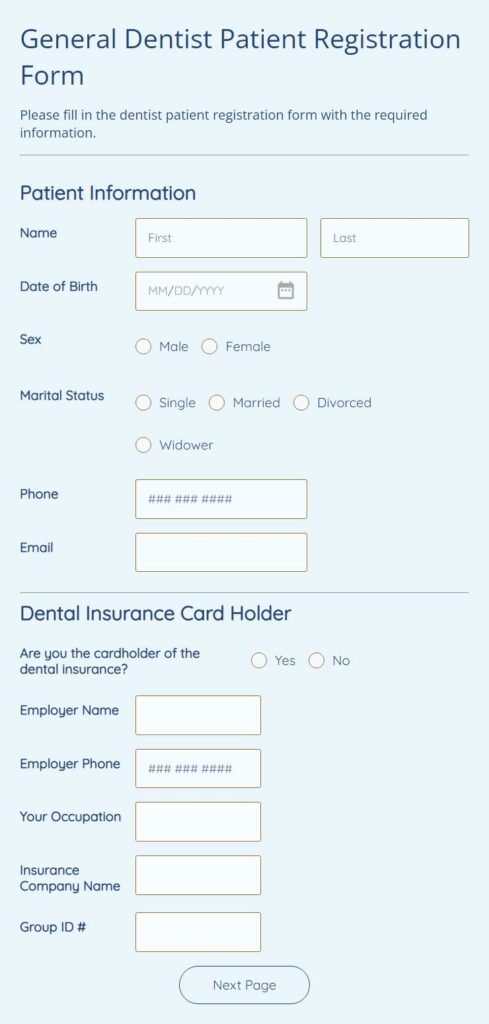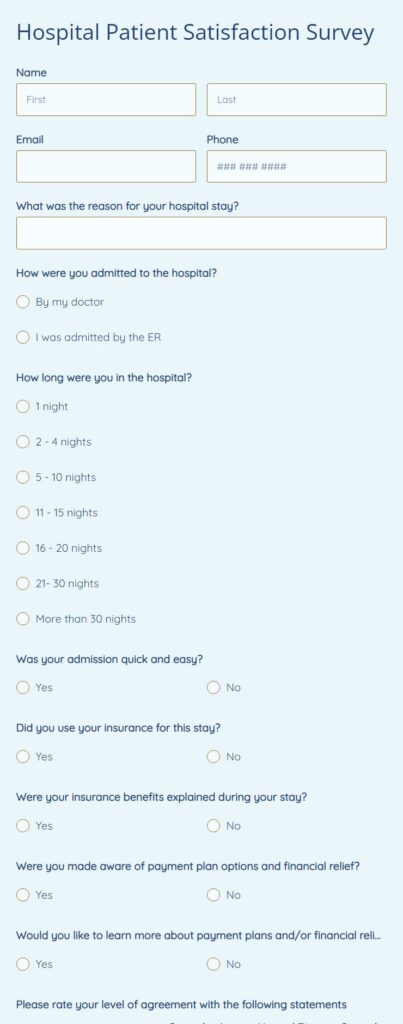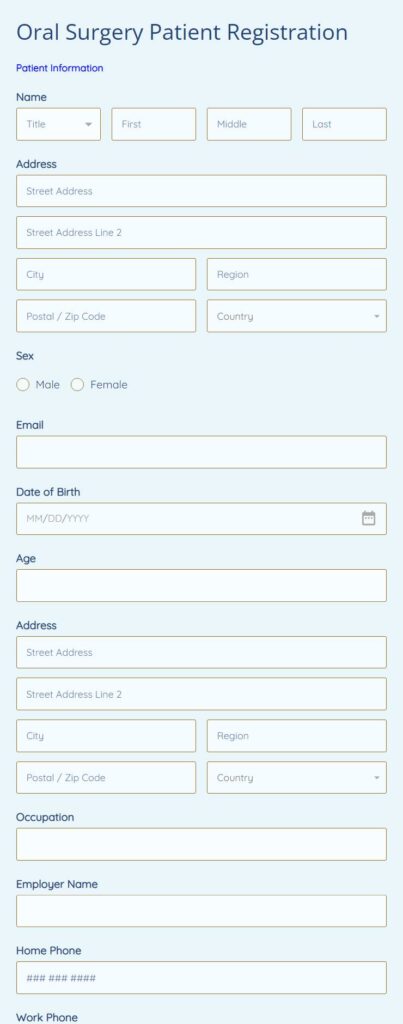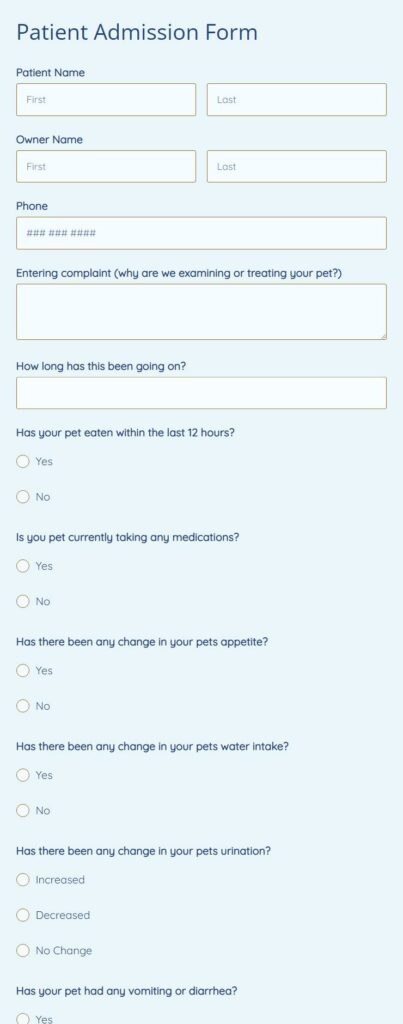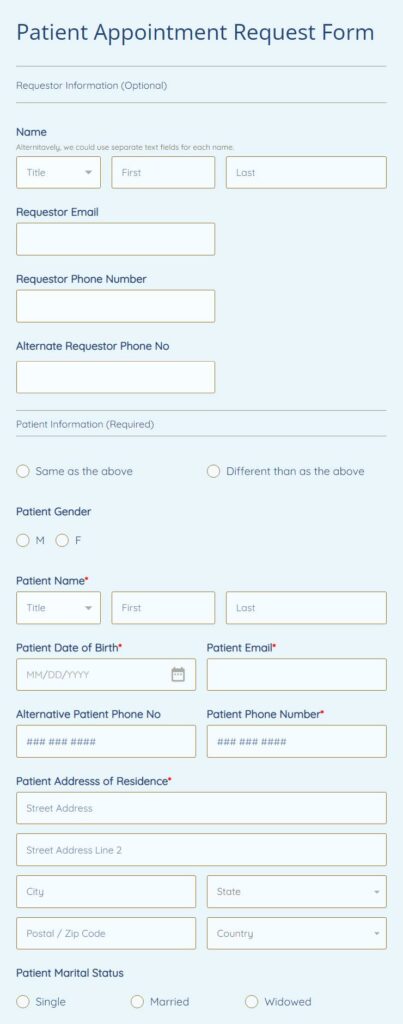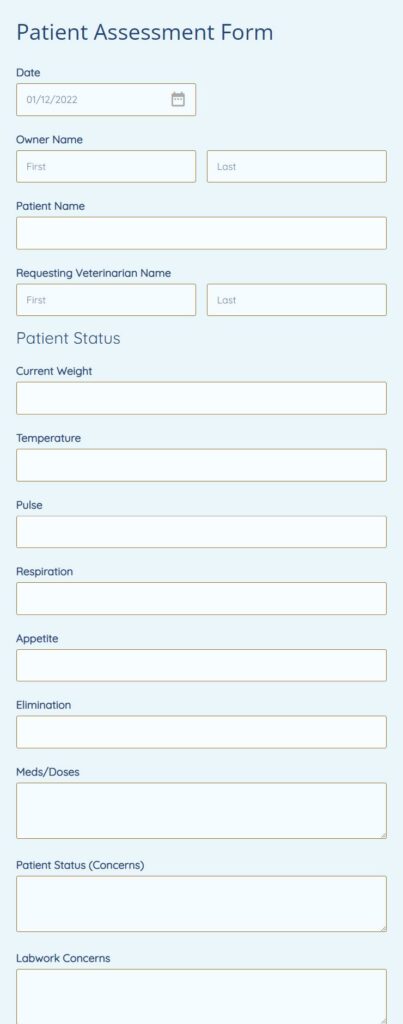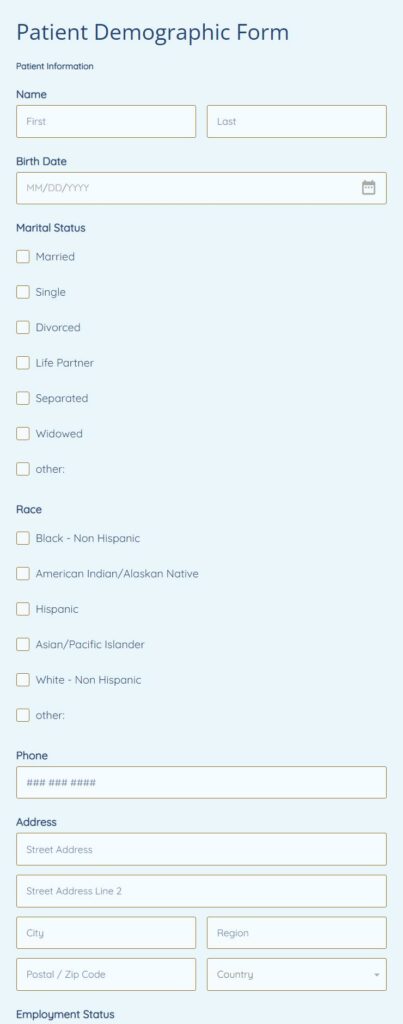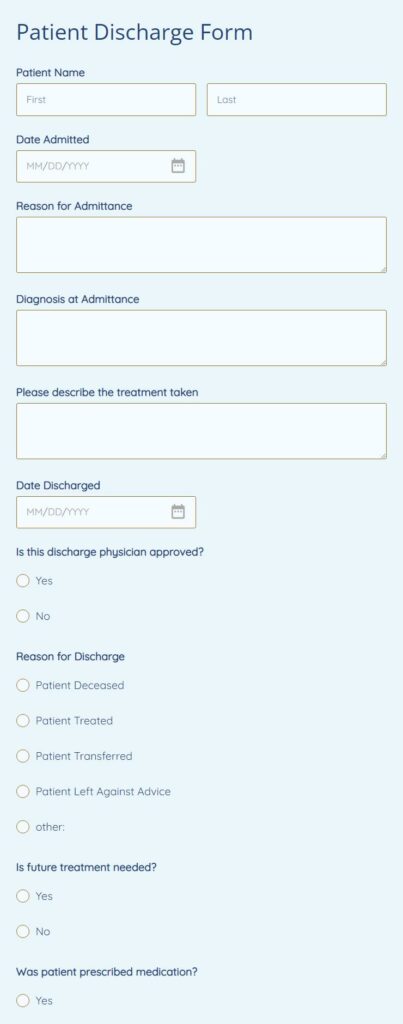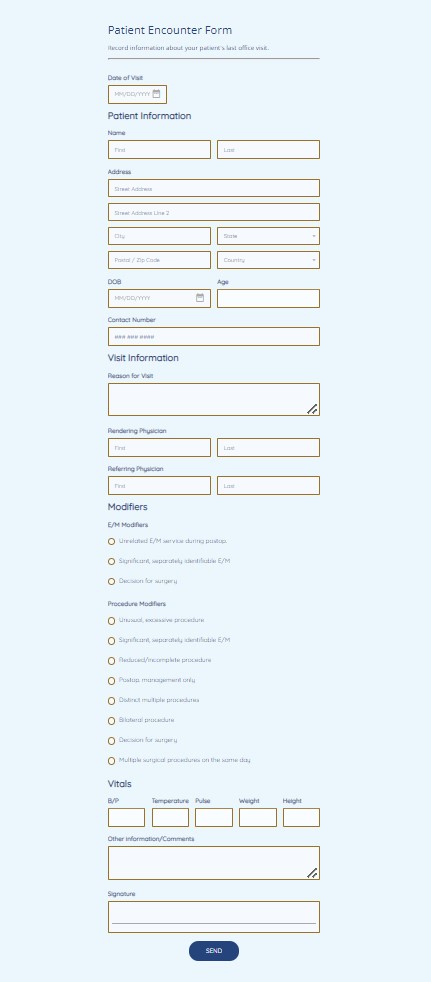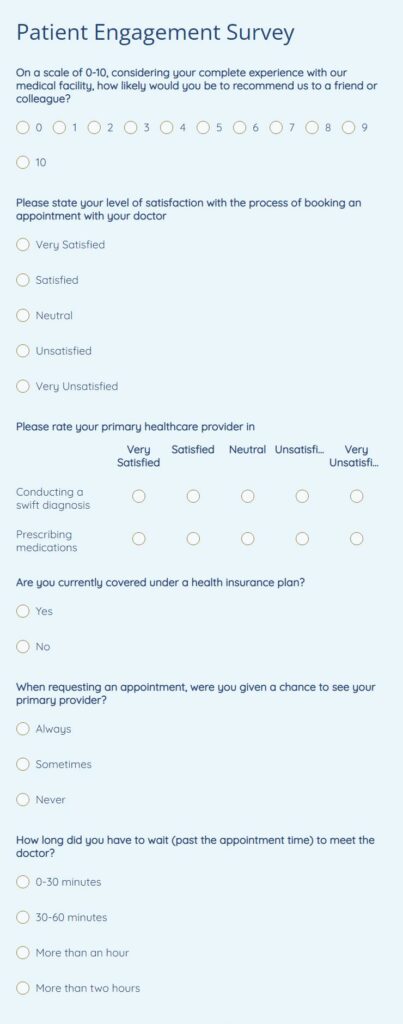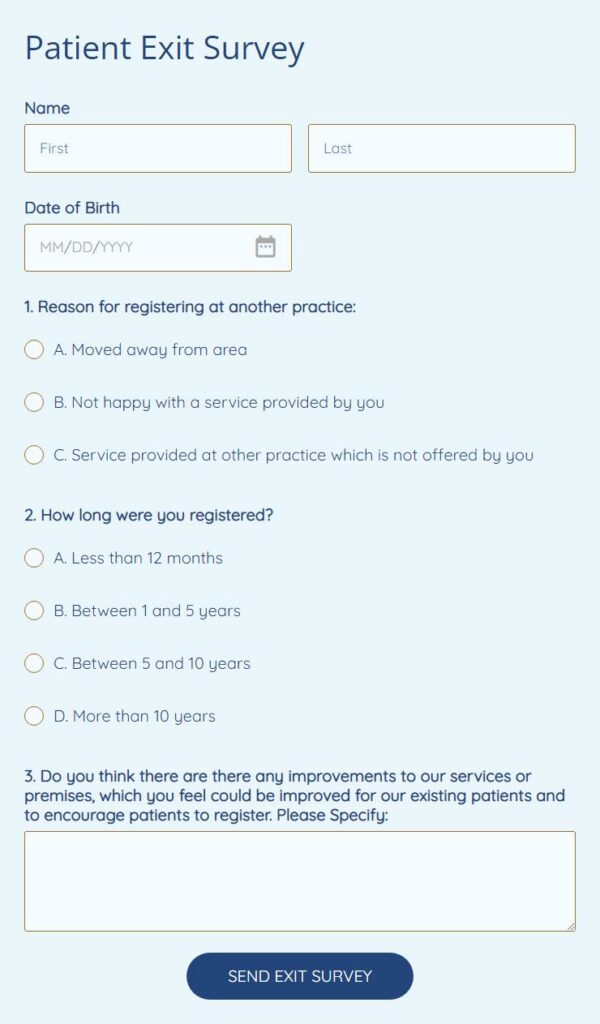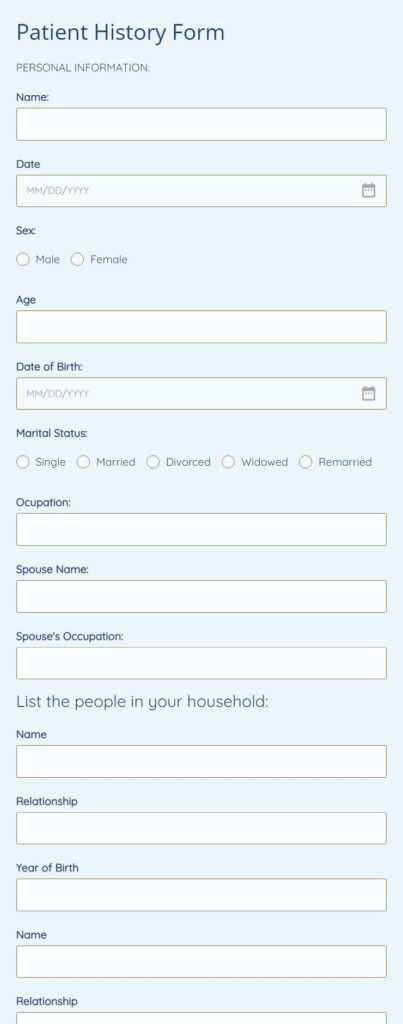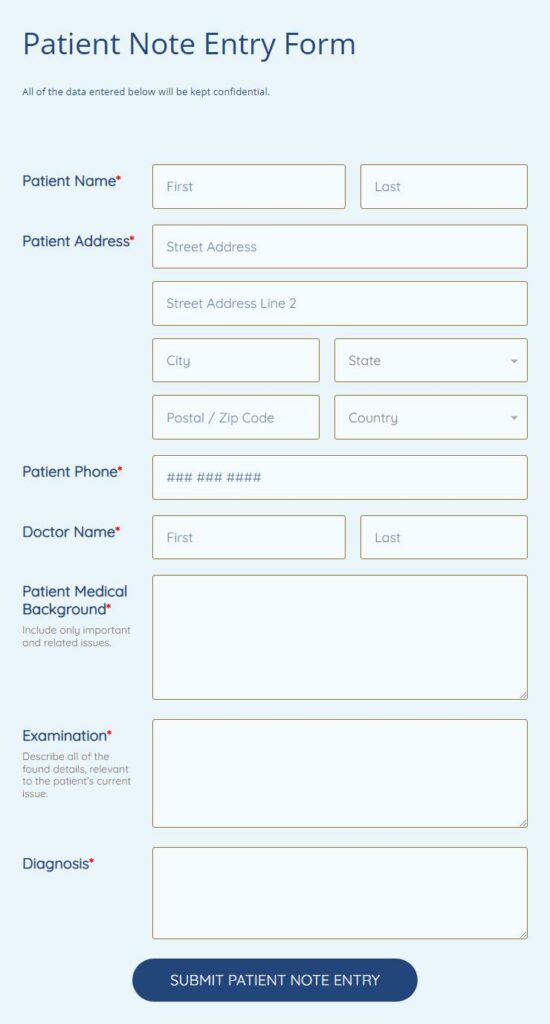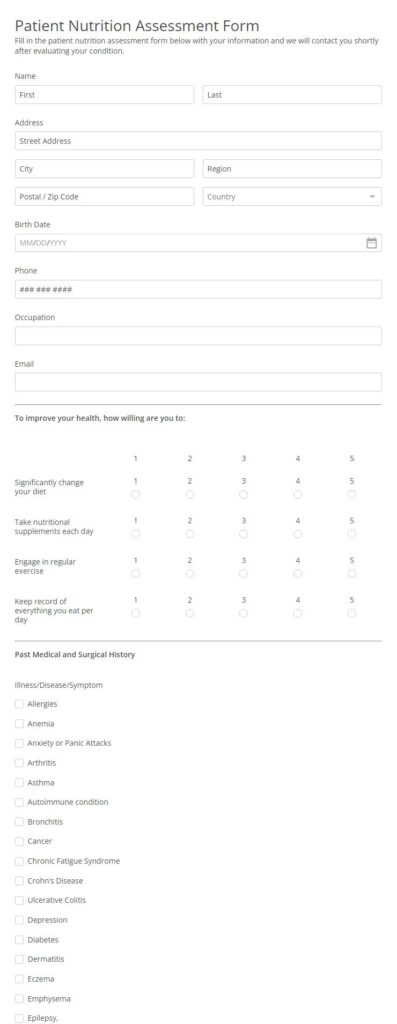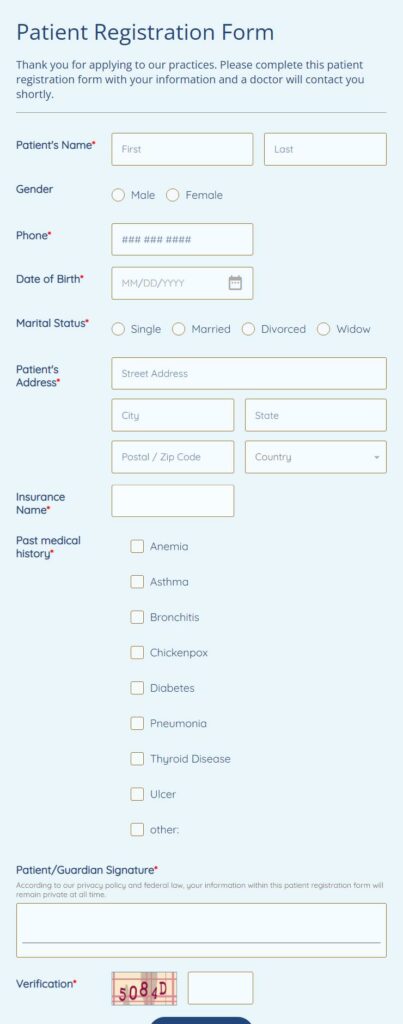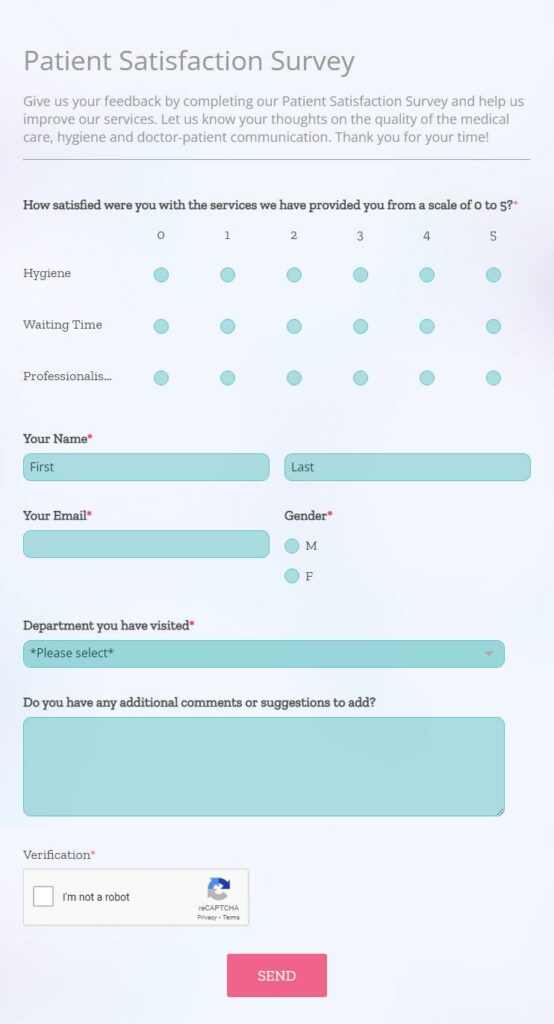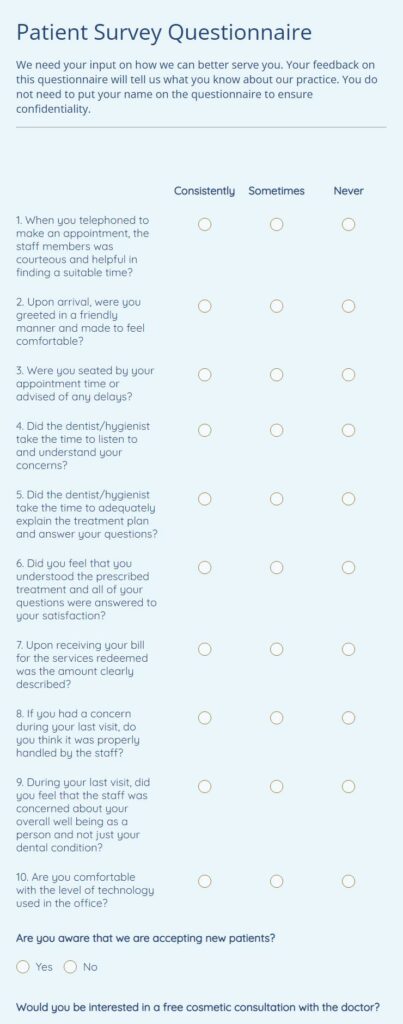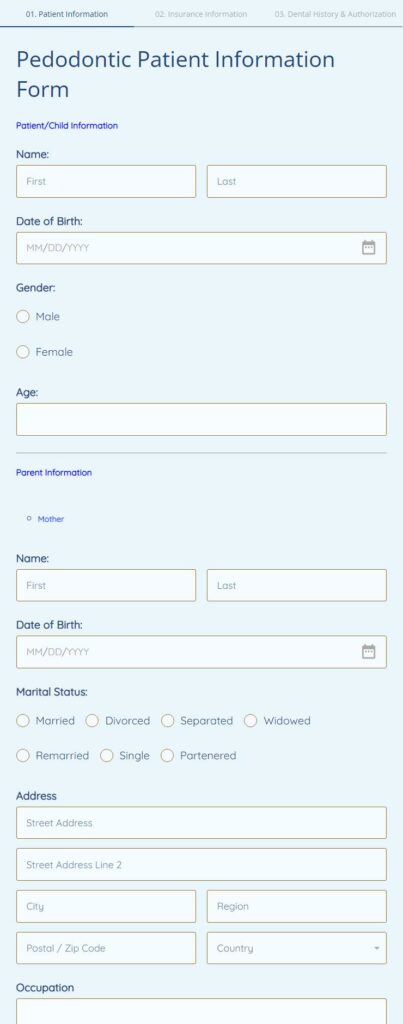25 Patient Forms to Make Your Medical Organization More Efficient
Providing high-quality medical care to your patients requires a seamless experience from start to finish. From the first day they walk into the practice, to their final day under your care, it’s your responsibility as a medical practitioner to ensure your patients are always well looked-after. You’ll need comprehensive electronic health records to keep up with patient documents and medical history. You’ll also need streamlined data collection methods—from patient screening forms to patient consent forms. What these needs boil down to is a quick and easy way to create and manage online forms for patient data collection. Luckily for you, we’ve got the solution—25 of them, in fact. Let’s take a look at the healthcare form templates available to you, and the benefits of using 123FormBuilder to create and manage them. These forms are 100% secure, and you’ve got the option to add HIPAA compliance features to ensure you’re fully covered.
We’ve got lots to cover, so let’s get started.
1. Endodontist Patient Registration Form Template
Who needs this?
This is an essential medical patient form to have on hand in a dental surgery office. If your practice offers endodontic services, you need a way to capture incoming patient information and patient data (and securely so!)
What’s it for?
This registration form collects all the key patient information you need to sign somebody up to the practice. If you’re working in a bigger medical center—like a hospital—this form is needed when patients progress from dental care to more specialized endodontistry.
Key benefits:
- Automated email notification: to quickly and easily identify new patients.
- Conditional logic process: helps speed things up by automating next steps—such as creating a PDF version within your patient files.
- Secure: This form is a secure way to collect information (and it is GDPR-compliant as well). Even more, there are also HIPAA-compliance features available for those who need to comply with HIPAA regulations when collecting patient information.
2. General Dentist Patient Registration Form Template
Who needs this?
Every dental surgery or practice needs a general dentist patient registration form. It’s the first step to bringing a new patient onto your books, and ensures you have all the required information to get started.
What’s it for?
This general dentist patient registration form provides all the key sections for collecting patient data: from name and date of birth to medical history and pre-existing dental conditions.
Key benefits:
- Paper-free: you’ll likely have people signing up on a regular basis—online forms can help cut down the amount of paper used for this process and reduce your dental surgery’s environmental impact.
- Easy to use: give your new patients a great first impression with a hassle-free sign-up form that they can complete anywhere.
- Upload field: for any necessary documents, such as personal ID or dental records.
3. Hospital Patient Satisfaction Survey Template
Who needs this?
A hospital patient satisfaction survey is a must for any hospital, regardless of whether the patient has been in the GI unit or at the podiatrist.
What’s it for?
This hospital form for patients is great to have on hand following any medical procedure or experience. It gives you insights into the patient experience and allows you to identify areas for improvement.
Key benefits:
- Fully customizable: this form template can be molded into exactly what you need it to be. Focus on the areas you deem important, and gather key insights into specific areas of your operations.
- Simple user experience: don’t fall at the final hurdle of patient satisfaction—ensure your form is simple to use.
- Conditional logic flow: this enables you to personalize the experience depending on previous answers. If a patient had a terrible experience, you don’t want your next question to ask what they loved about the stay.
4. Oral Surgery Patient Registration Form Template
Who needs this?
This is a key patient form for doctors, nurses, and oral surgery receptionists. New patients require dental surgery every day, and online forms create a more efficient process for collecting patient information.
What’s it for?
The oral surgery patient registration form collects the essential data you need from new patients, such as name, DOB, address, and medical history.
Key benefits:
- Integrations and automation: change how registration forms move through your oral surgery. By integrating with a wide variety of solutions—including Google workspace and Dropbox—you can quickly and easily share and access new patient information across relevant parties.
- Upload field: this ensures patients are able to quickly and easily upload key documents.
- Paper-free: digital patient intake forms mean you’re using less paper and creating a more sustainable workplace.
5. Patient Admission Form Template
Who needs this?
Sometimes medical issues call for inpatient care—a couple of nights under the full-time care of medical professionals. This could be overnight, or it could be for weeks or even months. Either way, you need patient admission forms to get the required info straight off the bat. Plus, its use isn’t limited to human healthcare—this can also be a key form for veterinary practices.
What’s it for?
Patient admission forms are key for collecting patient data ahead of inpatient care. It should provide information on the patient and their emergency contact, as well as details on why they’re being admitted.
Key benefits:
- Automated email notifications: help ensure everyone’s up-to-date on new patient info, and help notify the necessary individuals that a new patient has arrived for care.
- Eradicates human error: these forms include essential information for notifying emergency contacts in the case of issues. Having an online form that can’t easily be lost or modified ensures you’ve got the correct information at your fingertips at all times.
- Easy to use: incoming patients are likely already apprehensive and nervous about their stay in the hospital. Make life simpler with easy-to-use digital forms.
6. Patient Appointment Request Form Template
Who needs this?
This medical practice patient form is a must-have behind the reception desk of any practice or clinic.
What’s it for?
The request form enables patients registered at your practice to quickly and easily request an appointment. It includes key info on the patient, as well as space for the patient to provide details on the issues they’re seeking medical advice on.
Key benefits:
- Improve efficiency: by sending out digital patient intake forms, you speed up the process for both the patient and the practice.
- Fully customizable: alter key sections depending on your practice preferences and processes.
- Key integrations: integrate this form with existing processes to enable quicker patient management. For example, you could integrate with Google Calendar to enable patients to quickly find an appointment.
7. Patient Assessment Form Template
Who needs this?
Patient assessment forms are required at various stages of the medical assessment process. Both medical receptionists and medical practitioners need this form to collect info from patients.
What’s it for?
This form template enables healthcare professionals to assess patient needs, and determine possible illness diagnoses and treatments.
Key benefits:
- Easy to use: doctors will likely fill out multiple patient assessment forms a day—ensuring it’s a simple process helps speed things up.
- Fully customizable: the drag and drop form builder enables doctors to quickly customize patient assessment forms as per the unique requirements. The form won’t need to be altered for every patient, but it’s a useful feature for when it is necessary.
- Fully compliant: patient information and diagnoses are confidential—this form ensures you’re GDPR and also HIPAA compliant within the Enterprise plan.
8. Patient Demographic Form Template
Who needs this?
Patient demographic forms are issued by medical receptionists to gather better insights into the community of patients they’re serving.
What’s it for?
Patient demographics include identifying information such as name, date of birth, and address. Patient demographics streamline the medical billing process, improve healthcare quality, enhance communication and increase cultural competency.
Key benefits:
- Report dashboard: use the reports feature to view demographic data at a glance, and create a better picture of the patients at your practice.
- 100% secure: keep your patient’s data safe to avoid any issues, and add HIPAA compliance with the Enterprise Plan.
- Paper-free: patient demographics is one of many forms patients will complete while under your care—reduce your environmental impact by going paper-free.
- Integrate with existing processes: with other data collection tools to ensure all patient data is easily accessible.
9. Patient Discharge Form Template
Who needs this?
Doctors, nurses, and medical receptionists need to complete this form when discharging patients from their care.
What’s it for?
Patient discharge forms facilitate a smooth discharge of patients, and ensures they know what support is available to them.
Key benefits:
- Upload field: for any necessary images or documents that should be included in the patient discharge form.
- Automated email notifications: ensures that all the relevant healthcare professionals are notified of the change in patient status.
- Thank you page: this is a nice final touch for your patients, in which you can highlight any key info or contact numbers.
10. Patient Encounter Form Template
Who needs this?
This is a useful form for doctors or medical professionals to record a patient’s last office visit.
What’s it for?
A patient encounter form provides details on a patient’s visit, such as medical information and conversations with the medical professional.
Key benefits:
- Easy to use: for quickly reporting on patients between appointments.
- Paper-free: reduce your environmental impact and increase efficiency by going paper-free.
- No human error: online forms can easily be misplaced—remain professional by ensuring you’ve got full control over all your patient information and keep it online.
11. Patient Engagement Survey Template
Who needs this?
Clinics and hospitals need this form to accurately gauge how their patients feel about the services provided.
What’s it for?
With a patient engagement survey, you can efficiently get insights into your clinic, and how patients view your services. You can ask how likely they are to recommend you to a friend or family member, understand how satisfied they are with your services, and much more.
Key benefits:
- Fully customizable: the drag and drop tool enables you to add and modify sections to ensure you’re gathering insights on key aspects of your service.
- Reports dashboard: access survey responses via the reports feature, and get an overview of patient sentiment for seamless data management.
- Conditional logic process: personalize your survey and send patients to different questions depending on previous answers.
- Increase productivity: automate survey send out to improve efficiency in your data collection process.
12. Patient Exit Survey Template
Who needs this?
Patient exit surveys are given to patients when they leave the medical practice. Most clinics and GPs have patient exit surveys to find out why a patient is choosing to access medical services elsewhere.
What’s it for?
The patient exit survey asks questions about why a patient is leaving your practice, such as if they’re moving away from the area or if they’re unhappy with the services provided at your practice. It can provide great insights into where you could be doing better.
Key benefits:
- Integrate with other processes: to develop insights further. Collating all this info in one place can help identify recurring issues.
- Easy to use: just as you started with a simple process, end with one. Patients don’t want to be confused by their exit survey—make it as easy as possible.
- Increase productivity: exit surveys can easily be completed at home—there’s no need to fill up your waiting rooms with people taking surveys. Online patient exit surveys both reduce your environmental impact, and create a better experience for patients completing the exit survey.
13. Patient Health Questionnaire Template
Who needs this?
The patient health questionnaire can be given to patients by a medical receptionist or by a medical practitioner of any kind.
What’s it for?
The questionnaire template enables healthcare professionals to gather information on the patient’s condition before the consultation. It gives an overview of the patient’s issues, and allows the medical professional in question to gather some preliminary information.
Key benefits:
- Fully customizable: no matter what field of healthcare you’re in, a patient health questionnaire can speed up appointments. This template allows you to quickly and easily modify sections as per your needs—be that dentistry or cardiology.
- Streamline processes with integrations: key integration and automation capabilities allow you to quickly and easily sort and categorize patient data.
- Confidentiality compliance: all patient information is confidential—these online forms ensure you’re GDPR and also HIPAA compliant if choosing an Enterprise plan.
14. Patient History Form Template
Who needs this?
The patient history form is used by healthcare and medical providers to create a comprehensive overview of a patient’s medical history. It can be completed by the patient online or in-practice, or by a healthcare provider during an appointment.
What’s it for?
Patient history forms ensure medical providers have all the necessary information to provide well-informed diagnoses and advice. It’s an essential step in providing the best medical services possible.
Key benefits:
- Upload fields: make sure you get the best picture of your patient’s medical history by including the option to upload key documents or images. For example, a patient experiencing post-surgery complications may want to include medical documents pertaining to the surgery and any further healthcare they’ve received.
- No human error: taking all patient medical documents and forms online reduces the chance they’ll be lost or stolen.
- Integration capabilities: ensure you can quickly and easily send patient history forms to the medical professionals who need to access them.
15. Patient Intake Form Template
Who needs this?
Healthcare providers and receptionists need patient intake forms to quickly and easily gather information on patients—from existing conditions to demographic data.
What’s it for?
This form helps give healthcare providers an overview of patients ahead of an appointment. It’s for both new and prior patients, and provides an updated snapshot of their details and health.
Key benefits:
- Easy to use: incoming patients have enough to worry about without being confronted with a confusing form to register their details and requirements.
- Integrate with existing workflow: easily build patient profiles by integrating your free online patient intake forms with other patient management tools.
- Stay compliant: it’s essential to keep patient data confidential at all times—this patient intake form ensures data is collected in a GDPR and HIPAA compliant process.
16. Patient Monitoring Form Template
Who needs this?
Nurses, physicians, or any healthcare providers require access to patient monitoring forms.
What’s it for?
This patient monitoring form template enables healthcare professionals to observe patients in a systematic way. This ensures that everyone who needs access to the patient monitoring form can quickly and easily understand the information included.
Key benefits:
- Fully customizable: the drag and drop tool can be used to add or delete sections in your patient monitoring form. This enables you to include clinic or service-specific details on the patient.
- Paper-free: easily share patient monitoring forms with the relevant healthcare providers to speed up how your facility shares internal information.
- Easily accessible and difficult to lose: healthcare providers require quick access to these documents when visiting patients. Having everything in one place ensures they can access the information they need, and limits the chance of it getting lost when passing through multiple departments and practitioners.
17. Patient Note Entry Form Template
Who needs this?
Physicians and nurses use patient note entry forms to report on the findings of a medical assessment.
What’s it for?
The patient entry note is filled out upon completion of a medical appointment. It details the examinations performed by the medical practitioner and provides information on the diagnosis.
Key benefits:
- Quick and easy: medical practitioners need to be able to quickly complete patient note entries during or between appointments. Simple forms help facilitate this.
- Secure: patient information is confidential—using online forms ensures your information is secure.
- Integrate with existing systems: quickly and easily share patient note entries following an assessment with 123FormBuilder’s 80+ integrations.
18. Patient Nutrition Assessment Form Template
Who needs this?
A patient nutrition assessment form is used by medical practitioners to gather insights into the nutritional habits of their patients.
What’s it for?
The patient nutrition assessment template helps medical professionals to evaluate the nutrition intake and lifestyle of their patients to make more informed medical decisions.
Key benefits:
- Full compliance: with data and patient protection laws, such as GDPR and HIPAA if choosing the Enterprise plan.
- Fully customizable: to fit the needs of your clinic or surgery.
- Paper-free: limit your environmental impact by taking your forms online.
19. Patient Pain Assessment Form Template
Who needs this?
Doctors and healthcare providers use patient pain assessment forms before and during appointments.
What’s it for?
A patient pain assessment form helps medical practitioners gauge the pain level, pain frequency, and pain location of patients.
Key benefits:
- Customize as per your needs: customize the form depending on the field of medicine. If you’re a dentist, the pain will likely be limited to the mouth—so you can ask more specific questions.
- Automatic notifications: patients frequently pass through various healthcare professionals before receiving treatment. Automate your processes to quickly and easily notify key parties for providing treatment.
- Quick and easy: the last thing that in-pain patients want is a complex pain assessment. Speed things up and limit hassle by using online forms.
20. Patient Progress Tracking Form Template
Who needs this?
Tracking forms are used by a wide variety of medical professionals.
What’s it for?
Patient progress tracking enables you to collect information on patient progress and recovery. If a patient has an issue, this can also be recorded and monitored here.
Key benefits:
- Integrates with your existing flow: integrate the form’s responses with other patient management tools for a seamless patient overview.
- Improve productivity: take your practice online and quickly and easily access patient information without sorting through paperwork.
- Automated email notification: inform the whole team of a patient’s progress with simple email automation.
21. Patient Registration Form Template
Who needs this?
Any medical practice requires patient registration forms—whether that’s a dental surgery or a cardiology practice.
What’s it for?
Medical patient registration forms are one of the first forms patients will complete at your practice. It includes key patient information—from name and address to existing health conditions and current medication.
Key benefits:
- Quick and easy: make sure new patients aren’t driven away by complicated sign-up forms.
- Digitize your practice: take everything online and increase productivity with online forms and electronic medical records.
- Fully customizable: add and remove sections as per your practice’s requirements.
22. Patient Revocation Request Form Template
Who needs this?
Healthcare professionals use this medical patient form to collect details on requested changes from patients.
What’s it for?
A patient revocation request form is used by patients to request a change to their details—typically concerning privacy and communications. For example, if a patient was receiving care under a family plan—they could revoke permission for other family members to access their health records.
Key benefits:
- Easy to access and use: this form is frequently completed off the premises of the doctor’s office—it’s essential to ensure patients can easily navigate the form.
- Secure and private: revoking access rights can be a sensitive subject. This patient revocation request template ensures all information is confidential and protected under GDPR/HIPAA regulations.
- Key integration capabilities: easily save and store patient revocation requests in your existing patient management platform.
23. Patient Satisfaction Survey Template
Who needs this?
A patient satisfaction survey helps practice owners and key decision-makers improve the patient experience.
What’s it for?
By gathering insights on what patients like and dislike about your service, you can work towards creating a more enjoyable patient experience.
Key benefits:
- Report dashboard for insights: the online reports features enable you to view overall practice feedback, as well as focus on a specific piece of patient feedback.
- Customize your survey: generic questions can be useful, but for deeper insights, you should customize your patient satisfaction survey.
- Conditional logic asks the right questions: guide the questions depending on what patients have already answered. This can help you gather deeper insights into patient satisfaction.
24. Patient Survey Questionnaire Template
Who needs this?
Medical practices of all kinds require patient survey questionnaires to gather feedback from patients.
What’s it for?
A patient survey questionnaire gives patients the opportunity to rate the experience they’ve had with your practice—from their first encounter with a medical receptionist to their appointments in the practice.
Key benefits:
- Paper-free: for a more sustainable practice. Patient survey questionnaires should be sent out frequently—avoid wasting paper to do this.
- Customizable as per your needs: add and remove sections to gather the insights you need.
- Conditional logic process: to ensure your form adapts to answers and asks relevant questions.
25. Pedodontic Patient Information Form Template
Who needs this?
This form is for medical practitioners that provide dental healthcare to children.
What’s it for?
Pedodontic patient information forms gather patient details, as well as emergency contact information. Pedodontics refers to dental healthcare provision for children—parent details must be captured alongside patient data.
Key benefits:
- Easy to use: this form requires information on two individuals, the patient and their legal guardian. You want to ensure the data collection process is simple to avoid missing any key information.
- Secure and online: digitizing patient medical documents streamlines your approach to patient care and form retrieval.
- Upload field for images: ensure you’ve got all the necessary info on patients, including any necessary documents or images.
Wrapping Up on these 25 Patient Forms for the Medical Industry
Creating various medical patient forms is simple with 123FormBuilder. The drag and drop tool allows you to quickly and easily add or remove sections, and the countless integrations enable you to streamline your information and processes to your business’s current tech stack and operations. Online forms are easier to save and manage than paper forms, and built-in GDPR compliance capabilities ensures you’re ticking all the boxes when it comes to secure data. Plus, forms can be HIPAA-protected upon request with 123FormBuilders’ Enterprise Plan—that way, you’re covered on all fronts.
Patient Forms: Frequently Asked Questions
What information is needed for a new patient?
The information needed when registering a new patient includes:
- Name
- Date of birth
- Address
- Contact details
- Medical insurance/NHS number
- Sex
- Gender
- Previous medical practice
- Health information, such as existing conditions and medication
Additional information can be gathered, however, these are the basic requirements for registering new patients.
Why is it necessary to collect patient information?
Patient information collection is necessary because it enables healthcare professionals to provide personalized care. By having up-to-date information, nurses, doctors, and other healthcare professionals are able to quickly access key information and stay updated on a patient’s previous medical history.
How do you handle patient data?
It’s essential to handle patient data in accordance with GDPR and HIPAA policy. General data protection regulation (GDPR) in the UK and Health Insurance Portability and Accountability Act (HIPAA) in the US are regulations put in place to ensure patient data is handled appropriately.
What is patient data collection?
Patient data collection refers to the process of gathering patient information. This includes patient registration forms, patient assessment forms, patient discharge forms, and more.
How do you collect patient information?
Patient information is typically collected using forms—both online and paper forms. You can also get more in-depth insight from patient interviews.
What is a patient information form?
A patient information form is used to collect key patient information. This includes patient details, demographic information, and any other information regarding the patient’s involvement and experience with a medical practice.
What is the purpose of a patient registration form?
A patient registration form is used to register patients at a medical facility. It enables medical professionals to gather essential patient information, such as name, address, and existing medical conditions.
What is a patient information sheet?
A patient information sheet includes key patient details, such as name, date of birth, address, and more. It provides healthcare professionals with information on patients that enable them to contact and care for patients.
What are the different types of medical documents?
Medical documents are documents that detail the medical history of a patient. Some examples of medical documents include:
- Patient registration forms
- Patient assessment forms
- Laboratory results
- Correspondence between healthcare professionals
- X-Ray and other imaging reports
These documents ensure healthcare professionals have a full overview of the patient and the care required at all stages of a patient’s treatment.
What are medical records forms?
A medical records form provides key information on patients at your practice. It provides details on existing health conditions, previous medical conditions, immunization dates, allergies, and more.
What is a patient file called?
A patient file is otherwise known as a medical record. When this medical record is online, it’s known as a patient electronic health record (EHR).
Load more...
